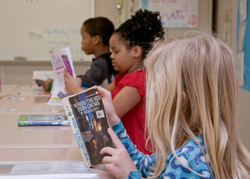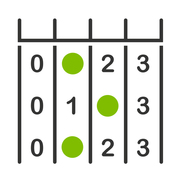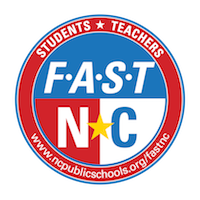
State Board of Education Continues Focus on Reading with Solution-Oriented Session
North Carolina’s persistent challenges with reading performance in the early grades remained at the top of the agenda this month for the State Board of Education, which devoted an additional issues session to the chronic problem.
Following last month’s focus on data showing a lack of significant progress under the state’s signature Read to Achieve initiative, the board this month considered presentations about potential solutions in North Carolina and successful efforts in other states to improve reading proficiency in early elementary grades.
J.B. Buxton, the chairman of the board’s Student Learning and Achievement Committee, prefaced the discussion by noting that a recent report in Education Week had ranked North Carolina 30th nationally on its index of “chance for success” over the course of a lifetime.
“We have challenges,” Buxton said. “Early reading is critical.”
One promising effort, launched this year on a pilot basis, is Wolfpack WORKS, a collaboration between N.C. State University’s College of Education and the Department of Public Instruction to help beginning teachers get started in the classroom with strong early literacy instruction. The program is currently serving 16 high-needs school districts, most of which are in the northeastern part of the state.
Jill Grifenhagen, an assistant professor of literacy education at the N.C. State College of Education and the principal investigator for Wolfpack WORKS, told the board that the pilot effort is reaching about 160 first- and second-year teachers and nearly 3,000 students. She explained that the program follows a three-pronged approach to ensure teachers are using proven strategies in reading instruction: face-to-face and online professional development, in-person and distance coaching and resources for classroom instruction.
“The work focuses on building the capacity and expertise of K-2 teachers in literacy,” Grifenhagen said, “so classroom teachers can meet the needs of most children. The classroom instruction needs to be of the highest quality.”
Several board members raised questions about the cost of expanding the reach of the Wolfpack WORKS program to include more districts, the availability of funding for the pilot effort and access by other teachers to the instructional resources.
The board also heard about the need to better support young children prior to kindergarten from Mandy Ableidinger, policy and practice leader for the N.C. Early Childhood Foundation.
“This is an urgent issue that we need to address in our state if we want to improve economic competitiveness going forward,” Ableidinger said. “If we want to address third-grade reading we need to start with our babies.”
She outlined The NC Pathways to Grade-Level Reading initiative as tackling one of the greatest challenges facing our state: the majority of our children are not reading proficiently by the end of third grade.
“Reading well in the early grades predicts a child’s academic and career success,” Ableidinger said. “Research shows that improving third-grade reading takes a coordinated birth-through-age-eight approach that focuses on children’s health and development, families and communities, and high-quality learning environments with regular attendance. It takes aligned policies and practices all working toward a common vision.”
Since 2015, hundreds of North Carolina leaders have worked across sectors, geography, and the political aisle to co-create Shared Measures of Success and an Action Framework for North Carolina.
The Pathways to Grade-Level Reading Measures of Success are research-based, whole-child, birth-through-age-eight measures that can help North Carolina determine if our young children are on the path to reading proficiently by the end of third grade.
|
The State Board of Education (SBE) endorsed the following after Ableidinger’s presentation: ·
-
Measures of Success Framework and recommends that they serve as the foundation for building North Carolina’s state and local birth-through-eight system work. The Pathways to Grade-Level Reading Action Framework provides North Carolina with a path forward on the areas Pathways stakeholders identified for action first – children’s social-emotional health, high-quality early care and education, and regular school attendance.
- Action Framework’s expectations for child and family systems, and agrees that the actions, if well-implemented, can improve children's third grade reading and well-being outcomes. The board recommends that North Carolina implement the actions outlined in the framework.
The concluding presentation to the board was from Cari Miller, policy director for early literacy at ExcelinEd, a Florida-based organization that has focused on early literacy.
Miller told the board that Florida’s success with gains in reading proficiency over more than a decade were the result of strong leadership, strong professional development and placing a high priority on strong reading instruction.
To strengthen North Carolina’s Read to Achieve program, she said, state leaders should consider taking steps to strengthen supports for teachers, raising cut scores on the exams required of new teachers and requiring individualized reading improvement plans for struggling readers.
“We know how to teach kids to read,” Miller said. “But we keep ignoring the science.”

Test-Reduction Steps Reviewed by Board
The State Board of Education got their first look at proposed testing changes announced last month by State Superintendent Mark Johnson.
Deputy Superintendent Eric Hall said that accountability staff has been working during the last few months to determine how to reduce the length of state exams and explore other strategies for limiting the stress that testing puts on students and schools.
Accountability Director Tammy Howard explained that the shorter exams will likely require a reduction in achievement levels for the state exams from the current five levels to four. The shorter exams, she said, will have fewer test items. The math tests for third and fourth grades, for example, will go from 54 items to 46; the biology end-of-course test will go from 75 to 65 items.
“The fewer the number of items, the less confidence you have in the levels,” Howard told the board. “We will need to go to four levels with fewer items.”
Board members also discussed the possibility of eliminating certain N.C. Final Exams, which were initiated several years ago to provide student performance data through the EVAAS system as a measure of teacher effectiveness. Tests now under consideration for elimination include a final exam for some fourth graders in science and a final exam in social studies for some fourth and fifth graders.
Several board members and advisors said they believe the stress that students and schools feel from testing is a result of the state’s accountability system that judges schools on the basis of student performance on summative exams.
“The punitive nature of A-F grades adds a huge amount of stress on teachers and into the classroom,” said board member Wayne McDevitt.
Tabari Wallace, the state’s current principal of the year and advisor to the board, asked what goal the test-reduction effort is aimed at achieving. “What is this designed to accomplish?” Wallace asked. “Have we really addressed the issue? If we reduce testing by an hour, does it get the root cause of the anxiety – in terms of our accountability framework?”
One of the board’s teacher advisors, Lisa Godwin, also pointed to the state accountability system that hinges on student performance on standardized tests.
“Can there not a be a way to combine testing with project-based learning and not just rely on that one day of testing?” Godwin asked.
|

Beginning Teachers Remain Concern in Latest State of Teaching Profession Report
Attrition rates among teachers in North Carolina remained largely unchanged from the last two years, according to the latest State of the Teaching Profession Report that was presented to the board this month. During the 2017-18 school year, about 8 percent of teachers were no longer teaching in the state’s public schools, while about 4.4 percent of teachers had moved to a different district in the state.
Tom Tomberlin, director of educator recruitment and support for DPI, told the board that while the data show no dramatic shifts from recent years, certain issues – particularly among beginning teachers – also remain a concern.
“What’s remarkable about this report is how unremarkable it is,” Tomberlin said. “There’s no evidence that teachers are fleeing the profession. I think the outgoing percentage is very, very stable. It’s not high.
“The focus has to be on the front end,” he said. “How do we increase the pipeline to make sure that the constant outflow doesn’t make us upside down so we won’t have enough teachers in the state.”
While the attrition rate for experienced, licensed teachers was about 7.25 percent last year, the report shows, the rate for teachers in their first three years was slightly more than 12 percent. Attrition rates among Teach for America teachers and visiting international faculty choosing to leave before their contracts had expired were also higher than the state average.
The retention of lateral entry teachers, Tomberlin noted, is of particular concern, since they represent an increasingly significant source of teachers for many schools in the state.
With an attrition rate of 15.5 percent, Tomberlin said, “their attrition rates in the early years are especially important. That is a concern we should continue to monitor.”
He also pointed to vacancies in elementary teaching positions as an increasing concern, in addition to more common and perennial shortages of teachers for math and exceptional children’s classrooms.
“Elementary has never been an issue,” Tomberlin said. “But districts are finding that’s increasingly problematic.”
|

FAST NC Hurricane Relief Effort Continues to Assist Affected Districts
Districts and schools hardest hit by Hurricane Florence continue to receive financial support from Florence Aid to Students and Teachers of North Carolina - FAST NC.
Among grants approved so far are these:
- Brunswick County Schools, Belville Elementary School: $10,000 to replace K-2 instructional rugs, PE equipment, and STEM materials and supplies
- Columbus County Schools, Elementary Arts Education: $834 to replace art books, materials and supplies
- Columbus County Schools, Tabor City Elementary School: $5,000 to replace library books, refurbished laptop computers, and copier supplies
- Columbus County Schools, Tabor City Elementary School: $12,120.00 for physical education equipment.
- Columbus County Schools, Tabor City Middle School: $500.00 to replace library books
- Duplin County Schools: $14,000 to replace 35 K-2 instructional rugs
- Onslow County Schools, White Oak High School: $14,000 to replace destroyed science supplies and materials
- New Hanover County Schools: $15,000 to reimburse teachers and teacher assistants for purchases of classroom supplies, books, and instructional rugs
- Pamlico County Schools, Pamlico County Middle School: $15,000.00 to replace athletic supplies and equipment.
- Pender County Schools: $14,000 for teachers and teacher assistants to use to replace instructional materials and supplies
- Public Schools of Robeson County Schools, Magnolia Elementary School (3 grants): grants to three teachers totaling $2,166.10 for classroom materials and supplies
- Public Schools of Robeson County: Migrant Education Program: $4,000.00 for books, materials and supplies, and food for students in the Migrant Education Program
The seventh round of applications will be received through Feb. 22. Round 8 applications will be received from Feb. 23 to March 8. Round 9 applications will be received from March 9 to 22.
To secure an application form, go to the FAST NC website (http://www.ncpublicschools.org/fastnc/) and click on the “Apply Now” link.
Donations of library books, school supplies and materials have been received at the North Carolina state textbook warehouse. These resources are available to the districts in the 34 counties that were declared federal disaster areas in the wake of Hurricane Florence. If you’re interested in obtaining books, materials, and supplies from the warehouse, email FASTNC@dpi.nc.gov or contact Drew Fairchild at Drew.Fairchild@dpi.nc.gov.
Please continue to help us get the word out and encourage others to give. Together, we can do so much to help students and school staff members who’ve suffered because of the hurricanes.
|
|